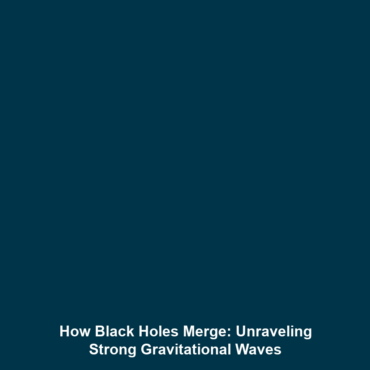How Black Holes Merge and Create Strong Gravitational Waves
Introduction
The phenomenon of black holes merging is not only one of the most fascinating aspects of astrophysics but also a major source of strong gravitational waves. These cosmic events enable scientists to probe the universe’s mysteries and validate Einstein’s theories of general relativity. Understanding how black holes merge is vital, as it offers insights into the fundamental nature of gravity and the evolution of galaxies. As gravitational waves ripple through the cosmos, they provide us with profound clues about the most powerful phenomena in the universe.
Key Concepts
The Process of Black Hole Mergers
When two black holes orbit each other, they create a gravitational wave. This process can be broken down into several key concepts:
- In-spiraling Phase: As black holes approach, they lose energy via the emission of gravitational waves.
- Merger Phase: The moment when the two black holes collide, resulting in a single, larger black hole.
- Ringdown Phase: The newly formed black hole settles into its final state, releasing a final burst of gravitational waves.
Applications and Real-World Uses
The study of black holes merging has significant implications in various fields:
- Astrophysics: Understanding galaxy formation and star evolution.
- Gravitational Wave Astronomy: New detection technologies are being developed based on black hole merger data.
- Cosmology: Insights into the early universe and dark matter.
These applications demonstrate how black hole mergers influence our understanding of gravitational waves and the broader universe.
Current Challenges
Despite advancements, several challenges remain in studying black hole mergers:
- Data Limitations: Difficulty in capturing data from distant and faint gravitational waves.
- Theoretical Models: Inadequate models that cannot fully explain the complexities of black hole interactions.
- Technological Constraints: Limitations in current detection technologies that hinder observational capabilities.
Future Research and Innovations
Future research in black hole mergers and their resulting gravitational waves promises exciting advancements:
- Advanced Detectors: Next-generation gravitational wave observatories like the LIGO and Virgo collaborations are anticipated to detect and analyze more events.
- Theoretical Physics: New theories might emerge to explain the intricate behaviors of merging black holes.
- Interdisciplinary Research: Collaboration between gravitational wave astronomy and other fields like quantum physics could lead to groundbreaking insights.
Conclusion
Understanding how black holes merge and create strong gravitational waves opens up a window into the complexities of the universe. As we continue to explore these cosmic phenomena, our grasp of gravitational dynamics expands, offering possibilities for future discoveries. For more information about gravitational waves and their significance in astrophysics, check out our overview of gravitational waves and related research articles.

Leave a Reply